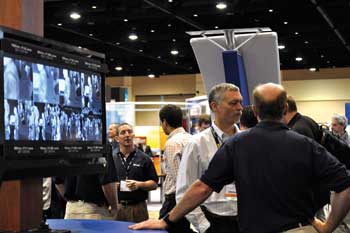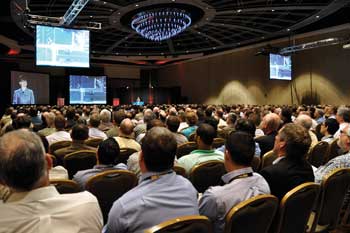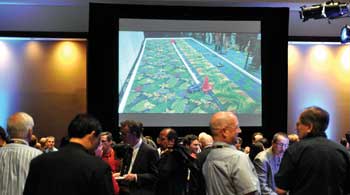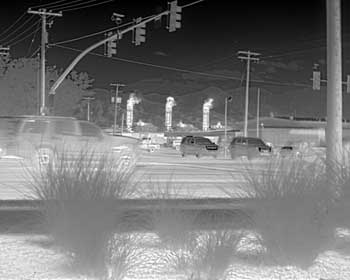SPIE moves its DSS conference and trade show to the Charm City to maximize exposure to governmental agencies, military institutions and research organizations.
At the mention of Baltimore, certain things come to mind: crab cakes, the Orioles, Camden Yards, Edgar Allan Poe’s grave and, now, defense and security technologies.
SPIE will host its popular annual conference and exhibition Defense, Security and Sensing in the Charm City this year – specifically, April 23-27 at the Baltimore Convention Center.

Camden Yards is one of the famous names associated with Baltimore — and now DSS will be as well. Photonics Media photo by Lynn Savage.
Organizers said the move from Orlando, Fla., was based on Baltimore’s proximity to noted research institutions, military installations, innovators and decision makers in defense R&D funding; the area’s growth in technological conferences and exhibitions; and even its popular sights and sites.
“In addition to providing a larger number of potential exhibition visitors, the move also provides room for growth in the exhibition – a trend which the event has been following for several years,” said Diane Cline, SPIE’s event manager for DSS. “Maintaining an East Coast location avoids disrupting accessibility for European participants and brings the meeting to within a drive for a large group of American participants.
“So, overall, we see the move as helping to accommodate industry growth and to enable more of the community to attend.”
As it has done every year, the event will bring together industry, military, government and academic engineers and scientists from all over the world. This year, DSS will offer more than 2400 presentations. The technical conference will include presentations on research in sensor systems and platforms; sensor and data analysis; video work flows and technologies for intelligence, surveillance, reconnaissance and situational awareness; compressive sensing; and cyber sensing.

More than 6000 industry professionals are expected to attend SPIE Defense, Security & Sensing in Baltimore this year. The exhibition will showcase more than 500 companies. Courtesy of SPIE.
More than 6000 industry professionals are expected to attend, and the exhibition will showcase more than 500 companies.
Plenary presentation
This year’s symposium-wide plenary talk will be given by Bruce Carlson, who has been director of the National Reconnaissance Office (NRO) since June 2009.
Carlson retired from the US Air Force in January 2009. He then served as a consultant to the defense industry and was a member of the board of directors at EADS North America, which focuses on defense and homeland security, commercial aviation, helicopters and telecommunications technologies.
In his current appointment, Carlson guides, directs and oversees the NRO, and also carries other assignments from the Secretary of Defense and the Director of National Intelligence.
DSS attendees set strategies, goals and directions for their organizations, Cline said. “To do so, they need to understand the concerns, future plans and strategies of the National Reconnaissance Office.”

The plenary, industry and technical lectures will give attendees a clear picture of the current state of photonics in the defense, security and sensing industry. Courtesy of SPIE.
Carlson’s talk will share the NRO perspective. “His comments should give the audience valuable insights on how to keep improving and developing the sensors, satellites and networking data that support intelligence systems.”
Technical events
“We are excited about the amount of defense technology and research to be presented at our new location in the Baltimore Inner Harbor,” said 2012 symposium chair Kevin Meiners, Acting Deputy Undersecretary of Defense for Portfolio, Programs and Resources. “We expect even more key funders and decision makers than ever to join us at SPIE Defense, Security and Sensing as a result of this proximity to many US federal government research labs and related industries.”
The technical conferences are organized by technology, grouped into program tracks and further gathered into sessions of papers on related topics. Program tracks include IR sensors and systems; defense, homeland security and law enforcement; imaging and sensing; sensing for industry, environment and health; emerging technologies; laser sensors and systems; innovative applications for displays; space technologies and operations; unmanned, robotic and layered systems; sensor data and information exploitation; signal, image and neural net processing; and information systems and networks: processing, fusion and knowledge generation.
“Photonics technologies are highly interdisciplinary,” Cline said. “Having the right variety of topics on the program is invaluable to researchers with new work to share and developers looking for solutions for their new ideas.

DSS offers a chance for researchers, engineers and other industry professionals to connect, discuss issues facing the community and spark new ideas. Courtesy of SPIE.
“The fact that technical attendees tend to hear talks in a variety of conferences bears this out. The infrared program track is a long-established and well-attended area, and we are seeing large numbers of papers in micronanotechnology and multi-/hyper-/ultraspectral imagery as well.”
The technical program also includes several special panel discussions and workshops, and poster sessions.
Panel discussion topics include motion imagery; standards; social/cultural modeling; geospatial information for intelligence analysis; and social networking innovations.
The invited panel discussion “Real-World Issues and Challenges in Social/Cultural Modeling with Applications to Information Fusion” will be hosted by Ivan Kadar of Interlink Systems Sciences Inc. and John J. Salerno Jr. of the US Air Force Research Laboratory. Panelists will come from Interlink Systems and the US Air Force Research Laboratory as well as SA Technologies, California State University-East Bay and Rochester Institute of Technology.
The discussion will focus on bringing the human aspect into the fusion area, particularly research and challenges in bringing this information to the assessment process. Information fusion involves combining information from multiple sources to find a consensus, Kadar said. Various methodologies, including but not limited to optical and photonic techniques, are used to gather that information.
Fusion models have focused mainly on physical systems to try to forecast potential impacts or threats, but they have largely overlooked the human side of the equation – but humans are the ones performing the actions. The panel’s objective is to bring social/cultural modeling, with all its challenges and potential benefits, to the attention of the fusion community.
“Social networking is a big deal now,” Kadar said. And additional information from social networking and other human sources, although it would make up a small percentage of the overall data, could have a significant impact on an assessment. “Where are you, where am I, am I a threat to you – it’s a very complicated issue,” he said.
The Infrared Materials Standards Working Group will bring together scientists and engineers who manufacture, test and use optical materials in the infrared to develop standards for properties of these materials. The working group will look at updating technical literature and existing databases on optical, mechanical, thermal and thermo-optical characteristics. The primary focus at first will be on optical and thermo-optical properties used for the design of infrared imaging systems.
Microscopy for educators
A special session, “Microscopy for STEM Educators,” will be an open forum for all meeting attendees and will feature invited talks on successful implementation of microscopy in STEM (science, technology, engineering and math) education to inspire student interest and excitement. The event will include a hands-on session with tabletop scanning electron microscopes, and attendees can bring their own objects to examine with the instruments. The session will be chaired by Michael T. Postek and Mary Satterfield, both of the National Institute of Standards and Technology.
“We held a ‘test run’ at NIST a few months ago with 12 educators from the local vicinity,” Postek said. “It was very successful, and the teachers indicated that they were willing to take a personal day to attend the Baltimore meeting. The instrument used at NIST has been traveling to schools in the area.”
The goal is simple but profound: “We need to rekindle excitement for STEM in the students,” Postek said. “These days, with desktop instruments, accessibility is enhanced, and thus microscopy is one window into the unseen world. Just look at the eyes of the students when they are looking at images of common items such as a dime or a spider enlarged several hundreds of times.”
The session is open to all DSS attendees, and SPIE has established special registration rates for STEM teachers.

DSS also will include more than 55 short courses on infrared systems, sensing, imaging, security, laser systems, optoelectronics and optical engineering. This year’s new course topics include night vision, high-dynamic-range imaging and energy harvesting. Professional development offerings will feature topics such as product innovation, ITAR/international trade and project management.
The Women in Optics presentation and reception will allow industry professionals to network and even gain a little inspiration. Alison Flatau of the University of Maryland will discuss her experiences in the NSF “Rotator” program, in which engineers, scientists and educators become temporary program directors known as rotators. They recommend proposals to fund, support cutting-edge interdisciplinary research, mentor junior research members and influence new directions in their fields and beyond.
Flatau has been involved in the SPIE Smart Structures and Materials conference for a long time as a conference, symposium and session chair, Cline said, and her work overlaps with defense and security. “In particular, her work in magnetostrictive materials, sensors and actuator dynamics, and noise and vibration control, connects with topics such as unmanned aerial vehicles,” she said. “In addition, her experience as a National Science Foundation program manager and her history of mentoring students and faculty as well as working as a researcher will be of interest to the audience.”
Industry events
DSS will feature several industry events, including vendor presentations with a special vendor reception, a panel on government funding and a panel on early-stage technology commercialization.
At the government funding session, speakers in government positions will inform the industry of their organizations’ anticipated future needs, allowing the industry to determine potentially profitable areas where they can invest and develop technologies.
“Contractors interested in where government funding organizations are going should not miss this session,” said Dr. Paul McManamon of Exciting Technology LLC, who will moderate the panel.
“This is not about immediate procurement opportunities,” he added. “It is about longer-term organization interests and strategies.” The industry-focused panel discussions and workshops on early-stage technology commercialization and government funding will feature representatives from the US Army Night Vision and Electronic Sensors Directorate, the US Missile Defense Agency, and the Department of Defense ISR programs as well as DARPA, Cline said.
Exhibition
The free exhibition will be held April 24-26 and will give contractors, suppliers and startups alike a place to showcase their latest lasers, sensors, optics and optoelectronics components as well as systems for image processing, spectroscopy and infrared imaging, and more. More than 500 companies are scheduled to participate. Several companies will offer hands-on demos of new technologies on the show floor. SPIE also will host the second annual Imaging Gallery Showcase as well as a job fair in the exhibition hall.
“We have seen a recent growth trend in the numbers of companies and positions at our job fairs, and expect this to continue next month in Baltimore,” Cline said.
Some exhibitors said they are looking forward to the change of location. “We anticipate that the new location will increase Flir’s exposure to agencies of the US government as well as customers in the mid-Atlantic and northeastern US,” said Jay James, vice president of OEM and ODM sales at Flir Commercial Systems Inc.
“The mix will be similar to recent years: The leading organizations in the industry will be joined by energetic startups and others new to the event, bringing their newest products and applications in cutting-edge technologies in optics, lasers, sensors, image processing, spectroscopy, infrared systems, optoelectronic components and related topics,” Cline said.
A number of companies will bring technology displays, she added: Flir will showcase its camera integrated with an unmanned aerial vehicle and helmet display; Intelligent Optics will show its nonlethal personal security device; Mantaro will demonstrate its telepresence robot; and Princetel will show its robotic vehicle with cameras, among others.

Flir high-resolution core cameras – such as the Tau, which was used to capture video from which this 640 x 512-pixel resolution image originates – as well as laser rangefinders, readout integrated circuits and pan-tilt mounts will be on display at the DSS exhibition. Courtesy of Flir Commercial Systems Inc.
“We are working hard to prepare our exhibit experience and contributions to the technical conference,” said Katie MacIntyre, marketing and public relations manager at Schott Defense. “We are working to maximize the proximity of government and DoD contacts in the Baltimore/Washington area, looking forward to seeing our existing customers and meeting new ones.”
Student events
SPIE has planned some special events just for students, including an introduction session called “Getting the Most Out of Your Conference Experience,” which will help new student attendees maximize their experience at the conference, among other events. “Topics range from professional development skills – from succeeding in a graduate program to getting hired and beyond – as well as networking opportunities including a social event at Camden Yards,” Cline said. “We are reaching out to students at the many optics and photonics related programs in the area and do expect an increase in the number of students attending this event.”